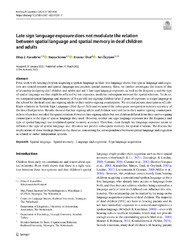Late sign language exposure does not modulate the relation between spatial language and spatial memory in deaf children and adults
| dc.contributor.author | Karadöller, D. Z. | |
| dc.contributor.author | Sümer, B. | |
| dc.contributor.author | Ünal, Ercenur | |
| dc.contributor.author | Özyürek, A. | |
| dc.date.accessioned | 2023-09-12T10:57:56Z | |
| dc.date.available | 2023-09-12T10:57:56Z | |
| dc.date.issued | 2023-04 | |
| dc.identifier.issn | 0090-502X | en_US |
| dc.identifier.uri | http://hdl.handle.net/10679/8800 | |
| dc.identifier.uri | https://link.springer.com/article/10.3758/s13421-022-01281-7 | |
| dc.description.abstract | Prior work with hearing children acquiring a spoken language as their first language shows that spatial language and cognition are related systems and spatial language use predicts spatial memory. Here, we further investigate the extent of this relationship in signing deaf children and adults and ask if late sign language exposure, as well as the frequency and the type of spatial language use that might be affected by late exposure, modulate subsequent memory for spatial relations. To do so, we compared spatial language and memory of 8-year-old late-signing children (after 2 years of exposure to a sign language at the school for the deaf) and late-signing adults to their native-signing counterparts. We elicited picture descriptions of Left-Right relations in Turkish Sign Language (Türk İşaret Dili) and measured the subsequent recognition memory accuracy of the described pictures. Results showed that late-signing adults and children were similar to their native-signing counterparts in how often they encoded the spatial relation. However, late-signing adults but not children differed from their native-signing counterparts in the type of spatial language they used. However, neither late sign language exposure nor the frequency and type of spatial language use modulated spatial memory accuracy. Therefore, even though late language exposure seems to influence the type of spatial language use, this does not predict subsequent memory for spatial relations. We discuss the implications of these findings based on the theories concerning the correspondence between spatial language and cognition as related or rather independent systems. | en_US |
| dc.description.sponsorship | Nederlandse Organisatie voor Wetenschappelijk Onderzoek | |
| dc.language.iso | eng | en_US |
| dc.publisher | Springer | en_US |
| dc.relation.ispartof | Memory and Cognition | |
| dc.rights | openAccess | |
| dc.rights | Attribution 4.0 International | |
| dc.rights | openAccess | |
| dc.rights.uri | https://creativecommons.org/licenses/by/4.0/ | |
| dc.title | Late sign language exposure does not modulate the relation between spatial language and spatial memory in deaf children and adults | en_US |
| dc.type | Article | en_US |
| dc.peerreviewed | yes | en_US |
| dc.publicationstatus | Published | en_US |
| dc.contributor.department | Özyeğin University | |
| dc.contributor.authorID | (ORCID 0000-0002-6794-2129 & YÖK ID 301136) Ünal, Ercenur | |
| dc.contributor.ozuauthor | Ünal, Ercenur | |
| dc.identifier.volume | 51 | en_US |
| dc.identifier.issue | 3 | en_US |
| dc.identifier.startpage | 582 | en_US |
| dc.identifier.endpage | 600 | en_US |
| dc.identifier.wos | WOS:000770191400001 | |
| dc.identifier.doi | 10.3758/s13421-022-01281-7 | en_US |
| dc.subject.keywords | Language and cognition | en_US |
| dc.subject.keywords | Sign language acquisition | en_US |
| dc.subject.keywords | Spatial language | en_US |
| dc.subject.keywords | Spatial memory | en_US |
| dc.identifier.scopus | SCOPUS:2-s2.0-85126344109 | |
| dc.relation.publicationcategory | Article - International Refereed Journal - Institutional Academic Staff |
Files in this item
This item appears in the following Collection(s)
Share this page




